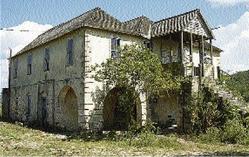A dark, dreary energy fills the air around Arcadia Great House in Arcadia Pen, Trelawny, as it towers over the expanse of cane fields below. Burnt, naked trees surround it and there is an overwhelming sense that blood was spilt on this ground. History reveals that its original owner, W.A Hankey, thought his slaves too indolent in their "pagan state" to be set free.
There is a gaping hole in the side of the building where his servants once resided; the stones which once filled it have been strewn carelessly by nature on the grass below. The house is magnificent, despite the vines which hang on the exterior, the mass of broken glass windows and the steps leading to the front door, almost entirely covered in some type of vegetation.
Built in 1820, years before the abolition of slavery in Jamaica, its watermarked ceilings are high, reflective of the popular Georgian architecture of its period. The arches of its windows manifest the same. Inside is filled with dust, mildew and rotting wood. The wooden floor creaks beneath each step and a spot of submergence reveals it will not hold much longer. Sure enough, there is a giant hole in the corner through which the bottom floor can be seen.
Vandals have stolen the doors and electrical wiring. They have written their phone numbers on the walls and down the spiral staircase lies a mass of debris. A rusted safe remains among the disintegrating wood, the only remaining relic, that is, in addition to what is left of the house.
Disrepair
Despite the historical significance of the house, The Jamaica National Heritage Trust has found the building too far in a state of disrepair to be declared an artefact worth preserving. Only two of about five great houses which are part of the Long Pond Estate have been declared national monuments by the trust.
"They really should all be declared, you know, because they are important aspects of our history intertwined with sugar in the parish. But with respect to the heritage trust, they don't have any money to do anything," says Dr Richard Harrison, CEO of the Sugar Company of Jamaica.
There is a unique quality to the Georgian inspired houses, fused with the distinctly Jamaican atmosphere and the clean country air. It is breathtaking and inspiring. Some have been left unoccupied for more than 10 years.
HYDE HALL GREAT HOUSE

Hyde Hall Great House, built in 1820, one of the Long Pond great houses. - photos by Andrew Smith/Photography Editor
It is the season for reaping and the scent of burnt sugar cane fills the nostrils of the reporter on the winding, rocky trail. A very large cotton tree looms over the area, masking a portion of the sky. Remnants of an old windmill tower sit across from the Hyde Hall Great House in Trelawny. So immensely covered in trees and fern it is, that it is easily mistaken for shade. To walk down this road is to step back into the 19th Century. It is a place suspended in time. Not far away, in the middle of a cane field, is the grave of a young man named George Dundas Hamilton. He died in 1833. His is only one of the graves still found in the area. Moss now grows along the stone walls of the house and one must tread carefully to avoid being stung by the wasps, with which the place is now infested.
Built in 1820, it is two-storied and has a triple-arched opening at the ground floor level. A cut-stone staircase now cracked and moldy with wooden balustrades gives access to the first floor level.
Lloyd Wright, research officer with the National Heritage Trust states: "This is probably one of the weaknesses of the heritage trust. We are not funded in a way that could give assistance to owner/occupiers for maintenance and repair and as a result, some of the properties are left to be weathered by the elements".
The 69-year-old watchman, Headly Brown, has lived on the ground floor of the great house for nearly 20 years and has seen people come to measure the building, but never anyone to repair the cracks in the walls caused by an earthquake some years ago.
"Gilbert blow, Ivan blow, an mi nuh si wah dem deh do an mi deh protect it. It shoulda inna betta condition. Dis yah house yah nuh deh a foreign. Is a nice living house. I don't see what they doing to it."

